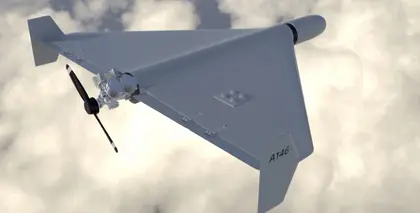The Kremlin plans to produce up to 150 Iranian kamikaze drones a month once it has set up a production facility on Russian territory, a representative of Ukrainian military intelligence has told Kyiv Post.
Andriy Yusov said that Russia currently relies on the weapons being shipped from Iran via the Caspian Sea, but recently revealed plans show Moscow is also receiving materials to build its own factory.
JOIN US ON TELEGRAM
Follow our coverage of the war on the @Kyivpost_official.
“There are reports that the Russians want to set up a large-scale assembly of Iranian drones in their country,” he told Kyiv Post.
“They [Russians] are aiming to reach an output of 100 to 150 units per month.”
Yusov also stressed that this number was a “benchmark they want to reach,” adding: “But it does not mean that they have such opportunities or will quickly reach them.”
Last week the White House said Russia is receiving materials from Iran to build a drone factory on its territory that “could be fully operational early next year.”
The White House released a satellite image of the location of the prospective plant in the Alabuga special economic zone, 900 kilometers (560 miles) east of Moscow.
“The Russia-Iran military partnership appears to be deepening,” White House national security spokesman John Kirby said in a statement, citing US intelligence information.
The Shahed drones have become an integral part of Russia’s bombing campaign against Ukrainian cities having launched thousands since October of last year.

Accidents, Not Russians, to Blame for Undersea Cable Damages, Western Intelligence Says
They only cost around $26,000 per drone compared to millions of dollars each for cruise and ballistic missiles.
The British Ministry of Defense, in an assessment on June 13, confirmed that Russia “is working to start domestic production of [Shahed drones], almost certainly with Iranian assistance.”
It added: “Russia is highly likely investing in [Shahed drones], because it provides Russia with a relatively cheap long-range strike capability at a time when it has expended a large proportion of its cruise missile stocks in Ukraine.”
Having a ready supply of 150 drones a month would provide Russia with a steady and consistent number of weapons to attack Ukraine with though it would not match the rate at which they expended them during May when the Kremlin dramatically increased its bombing campaign.
According to a Kyiv Post analysis, Russian launched 401 Shahed over the month. Ukrainian air defenses destroyed 362 of the incoming drones, over 90 percent of them.
Yuriy Ignat, a spokesman for the Ukrainian Air Force, said that Russia uses them at night to deplete Ukrainian air defenses.
"Iranian drones are a pain in the ass to shoot down anyway,” he said. “When many of them fly, they use different routes, they fly low to the ground, and it is difficult to attack them by plane because the drone’s speed is 150 kilometers per hour, and the fighter jet flies at a speed of at least 400 kilometers per hour.”
Ukrainian military intelligence representative Yusov commented on a British intelligence report about Iran increasing Shahid drone supply to Russia and helping to start its production on Russian territory.
“The delivery of Iranian drones via the Caspian Sea has been used as one of the main supply routes. There are reports that the Russians want to set up a large-scale assembly of Iranian drones in their country. They [Russians] aim to reach an output of one hundred to one hundred and fifty units per month.”
Of course, Iranian drones in the hands of the Russian occupiers pose a serious threat to Ukraine. First, for civilian infrastructure. And, second, they are a serious challenge for the Ukrainian air force and air defense, which will require strengthening the efforts of the international coalition to support the closure of Ukrainian skies to Russian aerial threats.
Over the past few months, Russia has been trying to establish long-term supplies of Iranian kamikaze drones and receiving large batches of relatively inexpensive UAVs transported by sea.
Against the backdrop of depleting missile stockpiles, Russia, with the assistance of Iran, is also preparing to launch the production of such drones on its territory – stated the UK Ministry of Defense, citing its intelligence.
Latest Defence Intelligence update on the situation in Ukraine - 13 June 2023.
— Ministry of Defence 🇬🇧 (@DefenceHQ) June 13, 2023
Find out more about Defence Intelligence's use of language: https://t.co/dDR5977XM6
🇺🇦 #StandWithUkraine 🇺🇦 pic.twitter.com/d4tdVmJ9fI
According to British intelligence, Russia has been making efforts to secure long-term supplies of large volumes of Iranian kamikaze drones in recent months. Iran is violating UN Security Council Resolution 2231 by transferring such weapons to Russia.
At the same time, with the help of Iran, Russia is preparing to launch its own Shahed production on its territory.
“Russia is highly likely investing in OWA-UAVs because it provides Russia with relatively cheap long-range capability at a time when it has expended in a large proportion of its cruise missile strokes in Ukraine,” British Intelligence stated.
According to US intelligence, Russia is setting up production of Iranian drones on its territory and has already received equipment for this purpose. Production is scheduled to start in early 2024, and the planned production site – the Alabuga Special Economic Zone in Tatarstan. The factory potentially will produce Shahed-136 kamikaze drones and Mohajer-6 reconnaissance drones.
The defense forces must spend anti-aircraft missiles shooting down a kamikaze drone. The Russians want to see where the Ukrainian systems are located and adjust their targeting for follow-on missile strikes.
You can also highlight the text and press Ctrl + Enter










